Experimental Investigation of Self-Compacting Concrete with Recycled Concrete Aggregate
Abstract
:1. Introduction
2. Experimental Program
2.1. Materials
2.1.1. Cement and Supplementary Cementitious Materials (SCMs)
2.1.2. Natural Aggregates and Recycled Coarse Aggregate (RCA)
2.1.3. Water
2.1.4. Polyvinyl Alcohol (PVA) Fibers
2.1.5. Superplasticizer (SP)
2.2. Mixing Proportions
2.3. Casting and Curing of the Specimens
2.4. Testing Procedures
3. Test Results and Discussion
3.1. Fresh Properties of SCC
3.1.1. Slump Flow Results
3.1.2. Segregation Resistance of the SCC Mixtures
3.1.3. L-Box Results
3.1.4. V-Funnel Test Results
3.2. Mechanical Properties of SCC Mixtures
3.2.1. Compressive Strength of SCC Mixes
3.2.2. Splitting Tensile Strength
3.2.3. Flexural Strength Results
3.3. Reinforced SCC Beam Results
4. Conclusions
- At 100% RCA, mixes with PVA fibers have less fresh properties than those without PVA fibers, demonstrating the adverse effect of PVA fibers on the fresh properties.
- Binary mixtures with MK only had the highest fresh properties compared with all other mixes, including ternary mixes with MK and FA or NS. In addition, quaternary SCC mixtures, including MK, FA, and NS, have the least fresh RA-SCC properties.
- The mechanical properties (compressive strength, tensile splitting strength, and flexural strength) of the SCC mixtures decreased as the RCA replacement ratio increased, demonstrating the negative influence of increasing replacement levels for RCA.
- Adding PVA fibers to the SCC mixes enhanced the splitting tensile strength; however, it decreased compressive and flexural strength at a replacement level of 100% for NCA.
- The compressive strength decreased for the ternary SCC mixtures, including adding FA and NS to cement. Nevertheless, ternary mixtures with MK and FA or MK and NS achieved asymptotic strength compared to the reference mixture, demonstrating that the mixes, including a combination of MK and FA or MK and NS, improve the mechanical properties of RA-SCC mixes.
- Increasing the RCA replacement level to 100% RCA for the ternary SCC beams with PVA fibers reduced the first cracking load, average ultimate load capacity, and average flexural stiffness. In contrast, increasing mid-span deflection, density, and width of cracks at the failure loads.
- The ultimate load and flexural stiffness for the reinforced SCC beams were significantly increased for the 100% RCA ternary mixes without PVA fiber content. The ultimate load for beams R100-MK-FA and R100-MK-NS increased by 3.15% and 3.7%, respectively, compared to the reference beam. Furthermore, flexural stiffness increased by 16.25% and 10%, respectively. However, the binary mixture with PVA fibers (R100-MK-PVA) had the highest ultimate load, increasing by 9.50% compared to the control beam.
Author Contributions
Funding
Data Availability Statement
Conflicts of Interest
References
- Guo, Z.; Jiang, T.; Zhang, J.; Kong, X.; Chen, C.; Lehman, D.E. Mechanical and Durability Properties of Sustainable Self-Compacting Concrete with Recycled Concrete Aggregate and Fly Ash, Slag and Silica Fume. Constr. Build. Mater. 2020, 231, 117115. [Google Scholar] [CrossRef]
- Kuder, K.; Lehman, D.; Berman, J.; Hannesson, G.; Shogren, R. Mechanical Properties of Self Consolidating Concrete Blended with High Volumes of Fly Ash and Slag. Constr. Build. Mater. 2012, 34, 285–295. [Google Scholar] [CrossRef]
- Pani, L.; Francesconi, L.; Rombi, J.; Mistretta, F.; Sassu, M.; Stochino, F. Effect of Parent Concrete on the Performance of Recycled Aggregate Concrete. Sustainability 2020, 12, 9399. [Google Scholar] [CrossRef]
- Musa, A.A. A Review on Recycled Aggregate Concretes (RACs). J. Phys. Conf. Ser. 2022, 2267, 012003. [Google Scholar] [CrossRef]
- Amario, M.; Rangel, C.S.; Pepe, M.; Toledo Filho, R.D. Optimization of Normal and High Strength Recycled Aggregate Concrete Mixtures by Using Packing Model. Cem. Concr. Compos. 2017, 84, 83–92. [Google Scholar] [CrossRef]
- Bahrami, N.; Zohrabi, M.; Mahmoudy, S.A.; Akbari, M. Optimum Recycled Concrete Aggregate and Micro-Silica Content in Self-Compacting Concrete: Rheological, Mechanical and Microstructural Properties. J. Build. Eng. 2020, 31, 101361. [Google Scholar] [CrossRef]
- Song, X.; Li, C.; Chen, D.; Gu, X. Interfacial Mechanical Properties of Recycled Aggregate Concrete Reinforced by Nano-Materials. Constr. Build. Mater. 2021, 270, 121–446. [Google Scholar] [CrossRef]
- Younis, A.; Ebead, U.; Suraneni, P.; Nanni, A. Short-Term Flexural Performance of Seawater-Mixed Recycled-Aggregate GFRP-Reinforced Concrete Beams. Compos. Struct. 2020, 236, 111860. [Google Scholar] [CrossRef]
- Revilla-Cuesta, V.; Ortega-López, V.; Skaf, M.; Khan, A.u.R.; Manso, J.M. Deformational Behavior of Self-Compacting Concrete Containing Recycled Aggregate, Slag Cement and Green Powders under Compression and Bending: Description and Prediction Adjustment. J. Build. Eng. 2022, 54, 104611. [Google Scholar] [CrossRef]
- Shafiq, N.; Kumar, R.; Zahid, M.; Tufail, R.F. Effects of Modified Metakaolin Using Nano-Silica on the Mechanical Properties and Durability of Concrete. Materials 2019, 12, 2291. [Google Scholar] [CrossRef] [Green Version]
- Anjos, M.A.S.; Camões, A.; Campos, P.; Azeredo, G.A.; Ferreira, R.L.S. Effect of High Volume Fly Ash and Metakaolin with and without Hydrated Lime on the Properties of Self-Compacting Concrete. J. Build. Eng. 2020, 27, 100985. [Google Scholar] [CrossRef]
- Prakash, R.; Raman, S.N.; Divyah, N.; Subramanian, C.; Vijayaprabha, C.; Praveenkumar, S. Fresh and Mechanical Characteristics of Roselle Fibre Reinforced Self-Compacting Concrete Incorporating Fly Ash and Metakaolin. Constr. Build. Mater. 2021, 290, 123209. [Google Scholar] [CrossRef]
- Yue, Y.; Zhou, Y.; Xing, F.; Gong, G.; Hu, B.; Guo, M. An Industrial Applicable Method to Improve the Properties of Recycled Aggregate Concrete by Incorporating Nano-Silica and Micro-CaCO3. J. Clean. Prod. 2020, 259, 120920. [Google Scholar] [CrossRef]
- Wang, S.; Zhu, B. Influence of Nano-SiO2 on the Mechanical Properties of Recycled Aggregate Concrete with and without Polyvinyl Alcohol (PVA) Fiber. Mater. Artic. 2021, 14, 1446. [Google Scholar] [CrossRef]
- Shi, C.; Wu, Z.; Lv, K.; Wu, L. A Review on Mixture Design Methods for Self-Compacting Concrete. Constr. Build. Mater. J. 2015, 84, 387–398. [Google Scholar] [CrossRef]
- Grdic, Z.J.; Toplicic-Curcic, G.A.; Despotovic, I.M.; Ristic, N.S. Properties of Self-Compacting Concrete Prepared with Coarse Recycled Concrete Aggregate. Constr. Build. Mater. 2010, 24, 1129–1133. [Google Scholar] [CrossRef]
- Kou, S.C.; Poon, C.S. Properties of Self-Compacting Concrete Prepared with Coarse and Fine Recycled Concrete Aggregates. Cem. Concr. Compos. 2009, 31, 622–627. [Google Scholar] [CrossRef]
- Sadeghi-Nik, A.; Berenjian, J.; Alimohammadi, S.; Lotfi-Omran, O.; Sadeghi-Nik, A.; Karimaei, M. The Effect of Recycled Concrete Aggregates and Metakaolin on the Mechanical Properties of Self-Compacting Concrete Containing Nanoparticles. Iran. J. Sci. Technol. Trans. Civ. Eng. 2019, 43, 503–515. [Google Scholar] [CrossRef]
- Khodair, Y.; Bommareddy, B. Self-Consolidating Concrete Using Recycled Concrete Aggregate and High Volume of Fly Ash, and Slag. Constr. Build. Mater. 2017, 153, 307–316. [Google Scholar] [CrossRef]
- Mohammed, S.I.; Najim, K.B. Mechanical Strength, Flexural Behavior and Fracture Energy of Recycled Concrete Aggregate Self-Compacting Concrete. Structures 2020, 23, 34–43. [Google Scholar] [CrossRef]
- Meena, A.; Singh, N.; Singh, S.P. High-Volume Fly Ash Self Consolidating Concrete with Coal Bottom Ash and Recycled Concrete Aggregates: Fresh, Mechanical and Microstructural Properties. J. Build. Eng. 2023, 63, 105447. [Google Scholar] [CrossRef]
- Yu, F.; Wang, M.; Yao, D.; Yang, W. Study on Flexural Behavior of Self-Compacting Concrete Beams with Recycled Aggregates. Buildings 2022, 12, 881. [Google Scholar] [CrossRef]
- Ignjatović, I.S.; Marinković, S.B.; Mišković, Z.M.; Savić, A.R. Flexural Behavior of Reinforced Recycled Aggregate Concrete Beams under Short-Term Loading. Mater. Struct. Constr. 2013, 46, 1045–1059. [Google Scholar] [CrossRef]
- Mohseni, E.; Saadati, R.; Kordbacheh, N.; Parpinchi, Z.S.; Tang, W. Engineering and Microstructural Assessment of Fibre-Reinforced Self-Compacting Concrete Containing Recycled Coarse Aggregate. J. Clean. Prod. 2017, 168, 605–613. [Google Scholar] [CrossRef]
- Mo, K.H.; Ling, T.C.; Cheng, Q. Examining the Influence of Recycled Concrete Aggregate on the Hardened Properties of Self-Compacting Concrete. Waste Biomass Valorization 2021, 12, 1133–1141. [Google Scholar] [CrossRef]
- Said-Mansour, M.; Kadri, E.H.; Kenai, S.; Ghrici, M.; Bennaceur, R. Influence of Calcined Kaolin on Mortar Properties. Constr. Build. Mater. 2011, 25, 2275–2282. [Google Scholar] [CrossRef]
- ECP 203; Egyptian Code of Practice for Design and Construction of Concrete Structures, ‘‘Annex III”, Manual Laboratory Tests for Concrete Material. Ministry of Housing, Utilities & Urban Communities: Cairo, Egypt, 2018.
- Available online: https://egy.sika.com/ (accessed on 10 March 2021).
- ECP 203; The Egyptian Code for Design and Construction of Concrete Structures. Ministry of Housing, Utilities & Urban Communities: Cairo, Egypt, 2018.
- EFNARC. Guidelines for Self-Compacting Concrete; English ed.; European Federation for Specialist Construction Chemicals and Concrete Systems: Norfolk, UK, 2002. [Google Scholar]
- EN 196-1 (Equivalence EN 196-1); Methods of Testing Cement—Part 1: Determination of Strength. Turkish Standards Institution: Ankara, Turkey, 2002.
- ASTM C496/C496M-17; Standard Test Method for Splitting Tensile Strength of Cylindrical Concrete Specimens. ASTM International: West Conshohocken, PA, USA, 2017.
- ASTM C78/C78M-18; Standard Test Method for Flexural Strength of Concrete (Using Simple Beam with Third-Point Loading). ASTM International: West Conshohocken, PA, USA, 2018.
- Manzi, S.; Mazzotti, C.; Bignozzi, M.C. Self-Compacting Concrete with Recycled Concrete Aggregate: Study of the Long-Term Properties. Constr. Build. Mater. J. 2017, 157, 582–590. [Google Scholar] [CrossRef]
- Kebaïli, O.; Mouret, M.; Arabia, N.; Cassagnabere, F. Adverse Effect of the Mass Substitution of Natural Aggregates by Air-Dried Recycled Concrete Aggregates on the Self-Compacting Ability of Concrete: Evidence and Analysis through an Example. J. Clean. Prod. 2015, 87, 752–761. [Google Scholar] [CrossRef]
- Behera, M.; Minocha, A.K.; Bhattacharyya, S.K. Flow Behavior, Microstructure, Strength and Shrinkage Properties of Self-Compacting Concrete Incorporating Recycled Fine Aggregate. Constr. Build. Mater. 2019, 228, 116819. [Google Scholar] [CrossRef]
- Liu, K.; Wang, S.; Quan, X.; Duan, W.; Nan, Z.; Wei, T.; Xu, F.; Li, B. Study on the Mechanical Properties and Microstructure of Fiber Reinforced Metakaolin-Based Recycled Aggregate Concrete. Constr. Build. Mater. 2021, 294, 123554. [Google Scholar] [CrossRef]
- Etxeberria, M.; Vázquez, E.; Marí, A. Microstructure Analysis of Hardened Recycled Aggregate Concrete. Constr. Build. Mater. 2006, 58, 683–690. [Google Scholar] [CrossRef]
- Omary, S.; Ghorbel, E.; Wardeh, G. Relationships between Recycled Concrete Aggregates Characteristics and Recycled Aggregates Concretes Properties. Constr. Build. Mater. J. 2016, 108, 163–174. [Google Scholar] [CrossRef]
- Li, K.F.; Yang, C.Q.; Huang, W.; Zhao, Y.B.; Wang, Y.; Pan, Y.; Xu, F. Effects of Hybrid Fibers on Workability, Mechanical, and Time-Dependent Properties of High Strength Fiber-Reinforced Self-Consolidating Concrete. Constr. Build. Mater. 2021, 277, 122325. [Google Scholar] [CrossRef]
- Yaowarat, T.; Horpibulsuk, S.; Arulrajah, A.; Mohammadinia, A.; Chinkulkijniwat, A. Recycled Concrete Aggregate Modified with Polyvinyl Alcohol and Fly Ash for Concrete Pavement Applications. J. Mater. Civ. Eng. 2019, 31, 04019103. [Google Scholar] [CrossRef]
- Duan, Z.; Singh, A.; Xiao, J.; Hou, S. Combined Use of Recycled Powder and Recycled Coarse Aggregate Derived from Construction and Demolition Waste in Self-Compacting Concrete. Constr. Build. Mater. 2020, 254, 119323. [Google Scholar] [CrossRef]
- Turatsinze, A.; Garros, M. On the Modulus of Elasticity and Strain Capacity of Self-Compacting Concrete Incorporating Rubber Aggregates. Resour. Conserv. Recycl. 2008, 52, 1209–1215. [Google Scholar] [CrossRef]
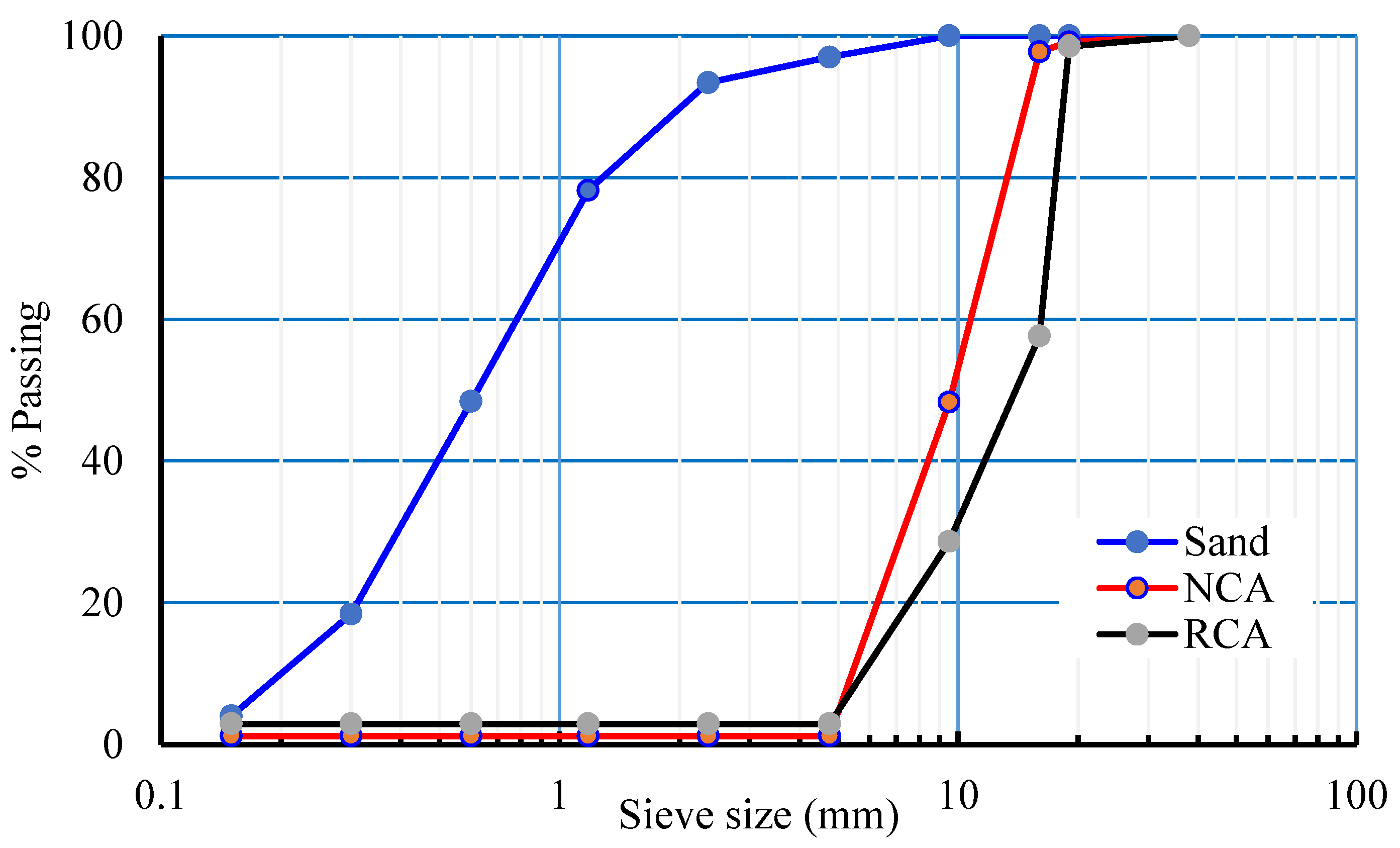
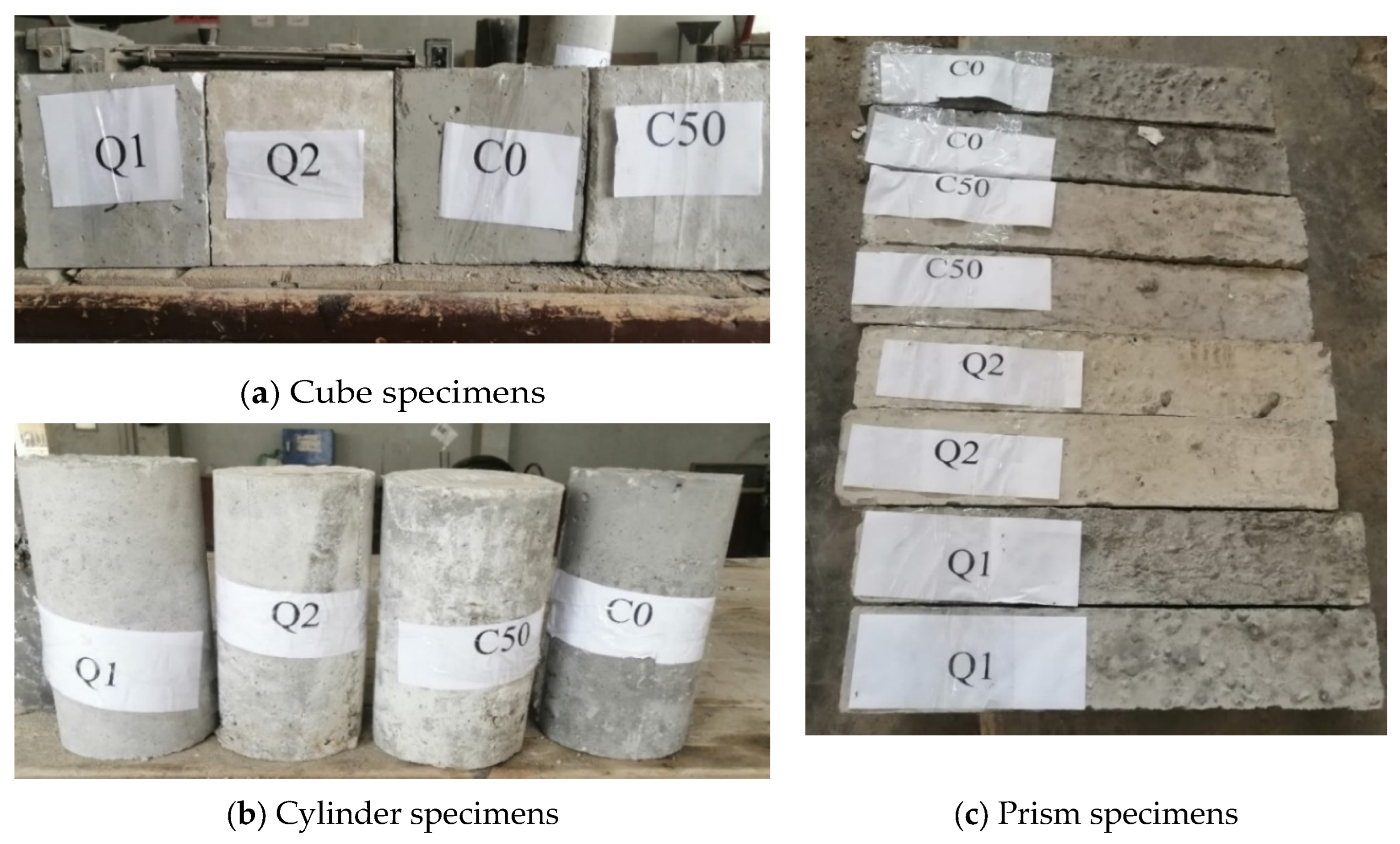


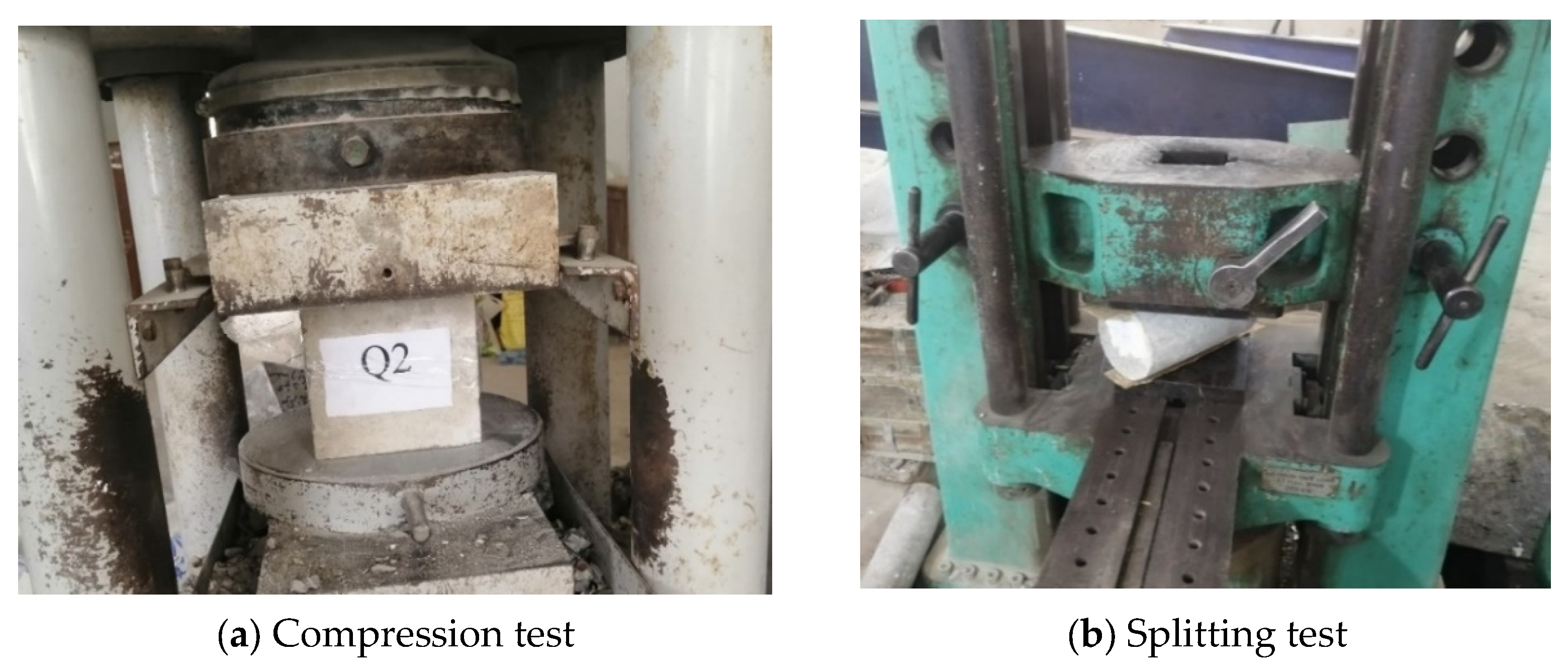
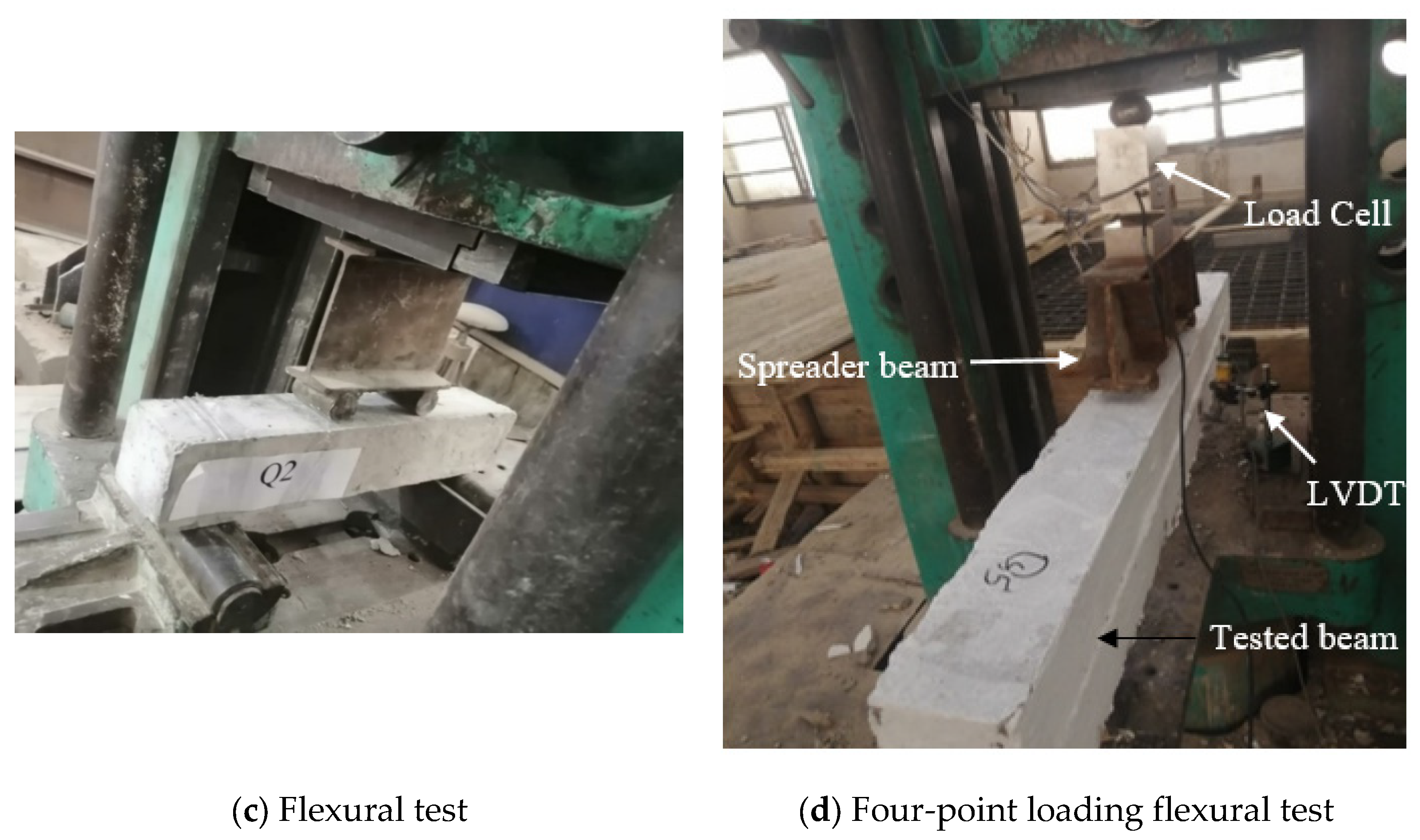
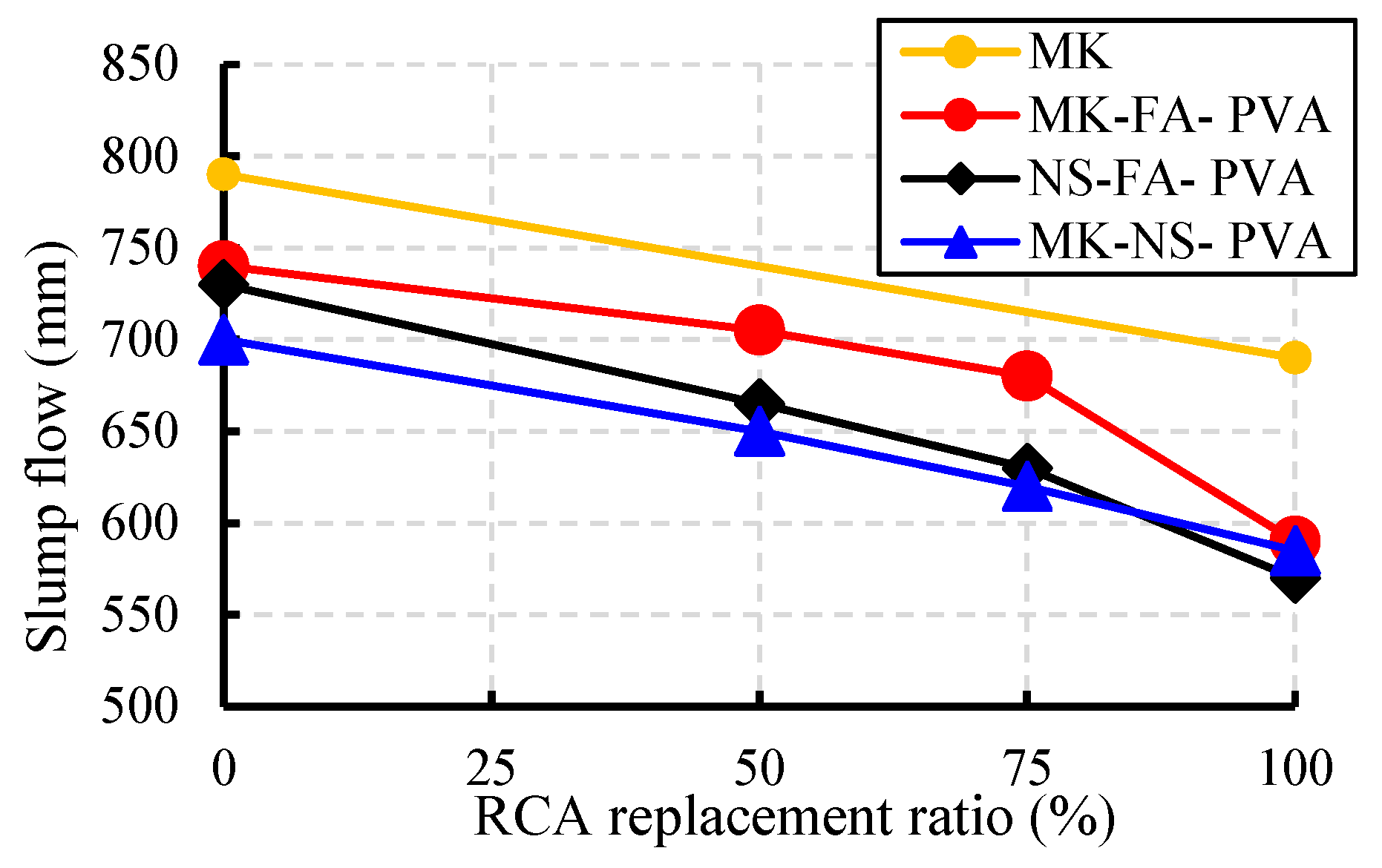
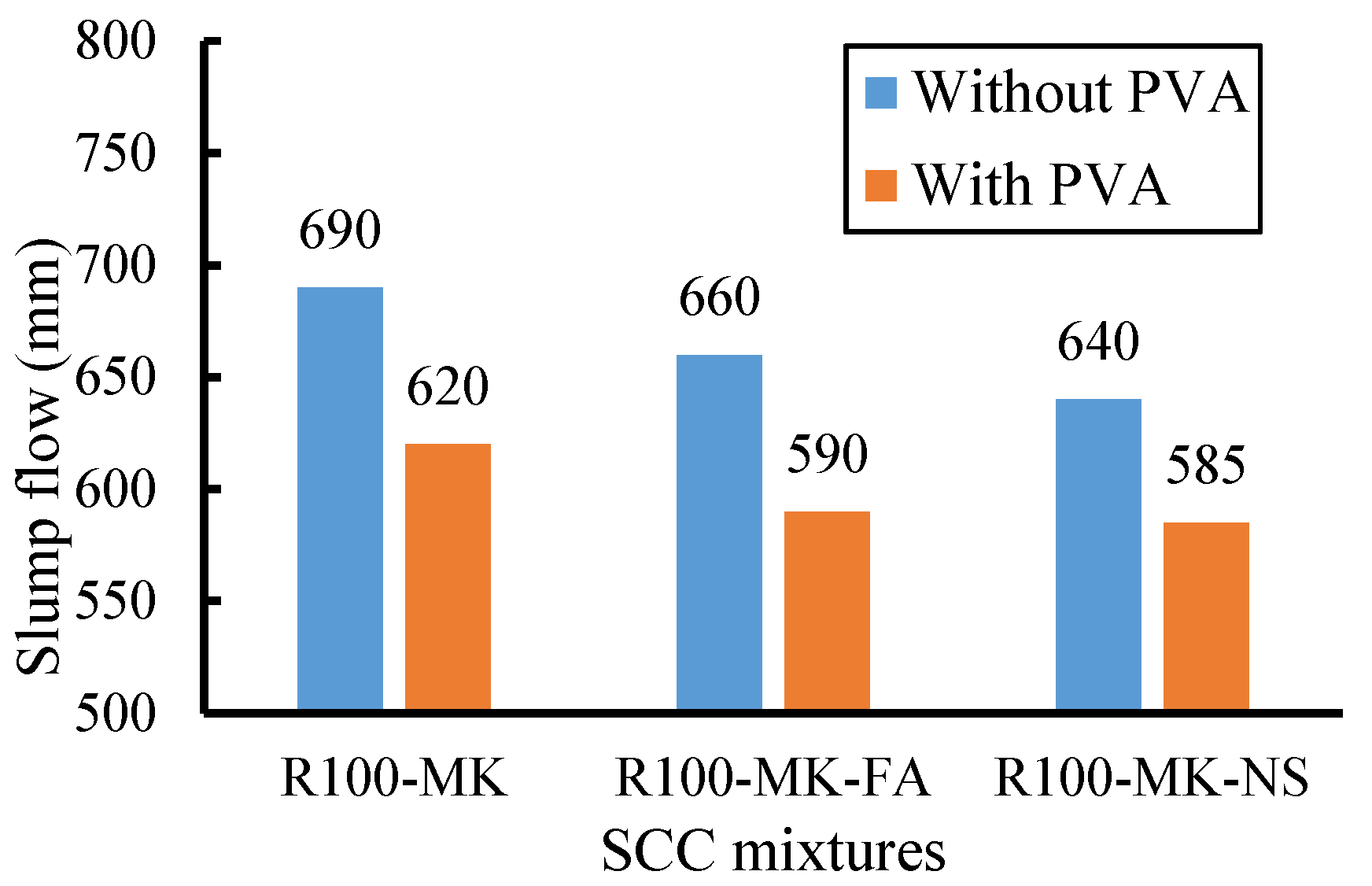


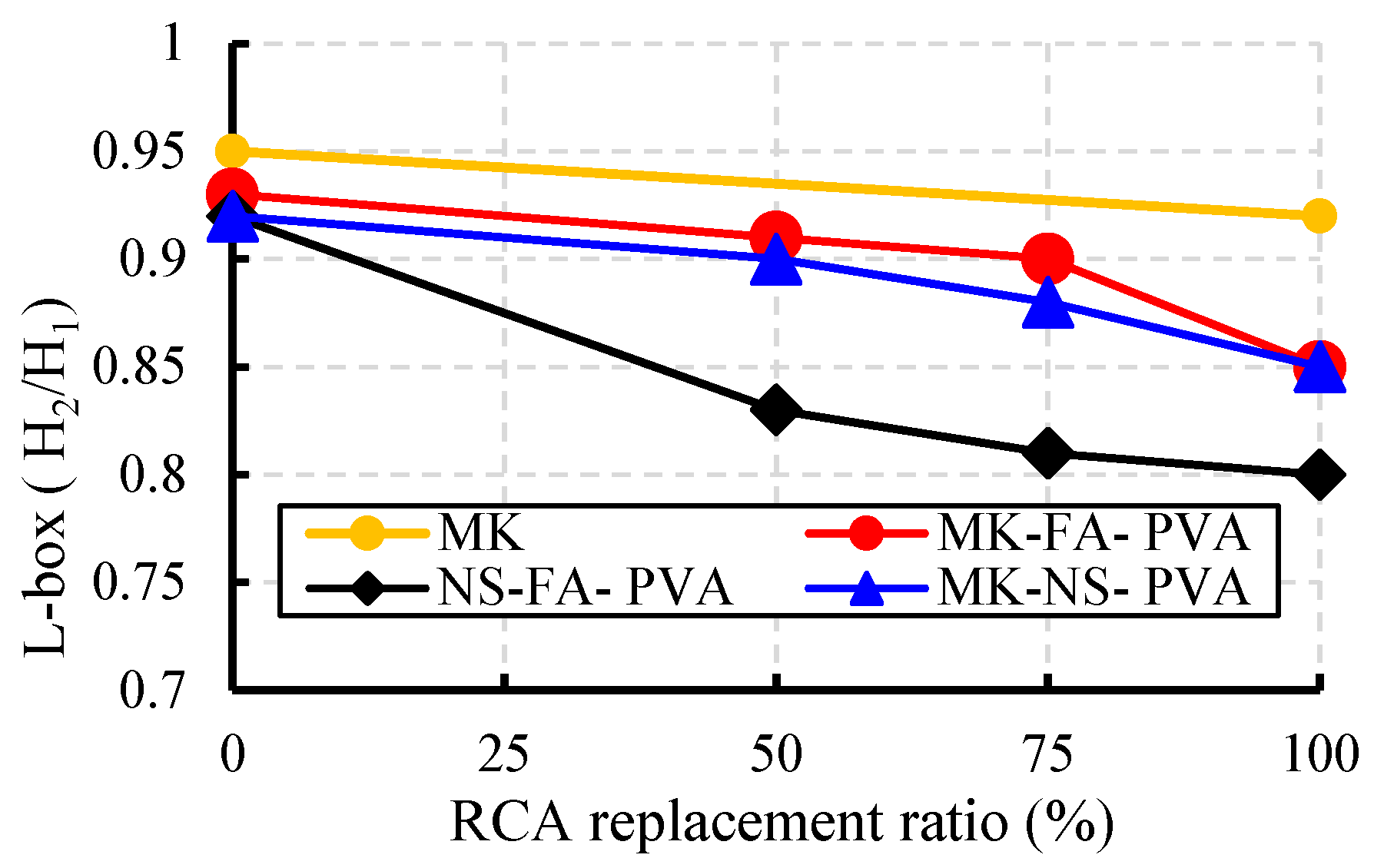
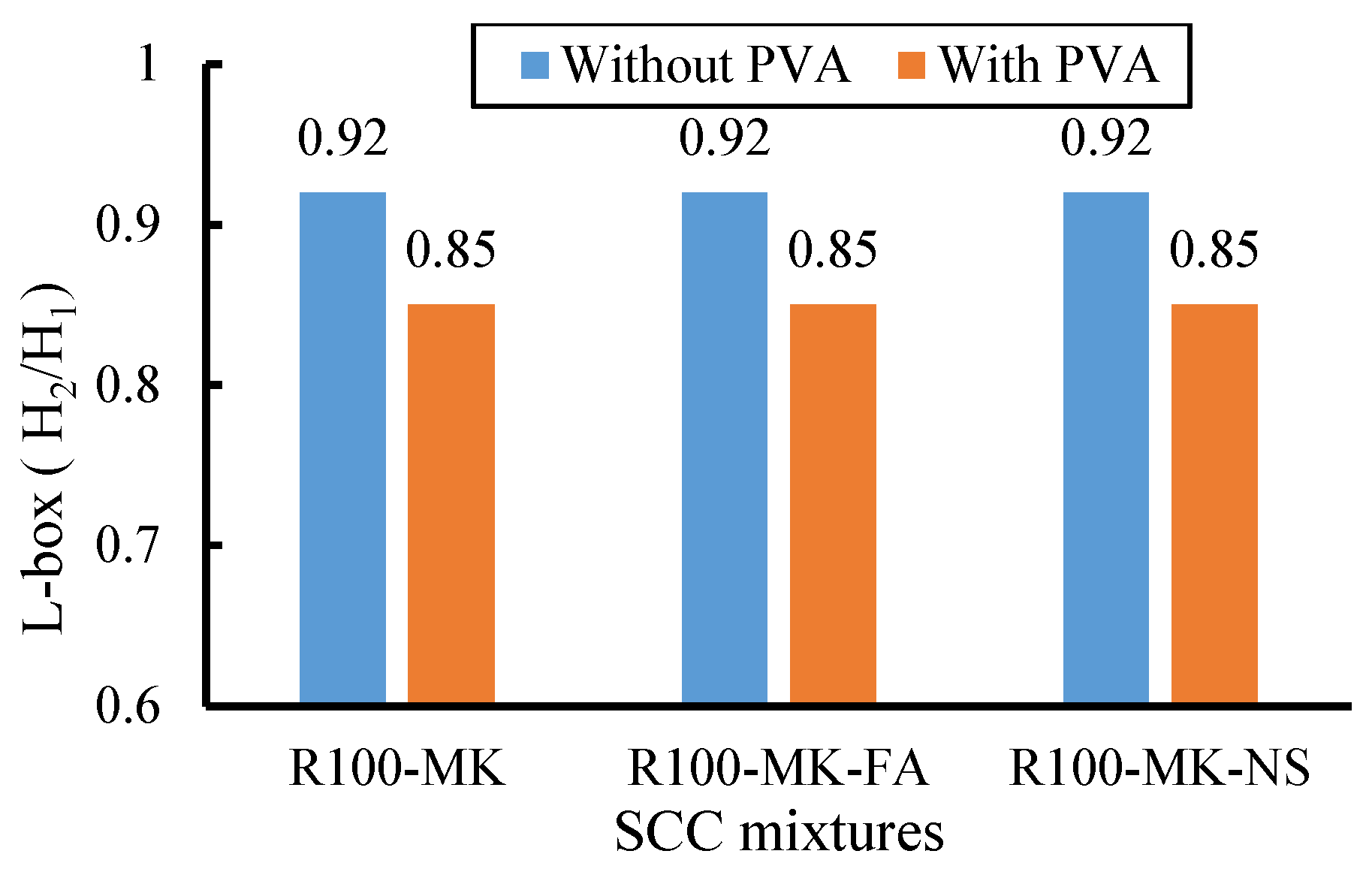

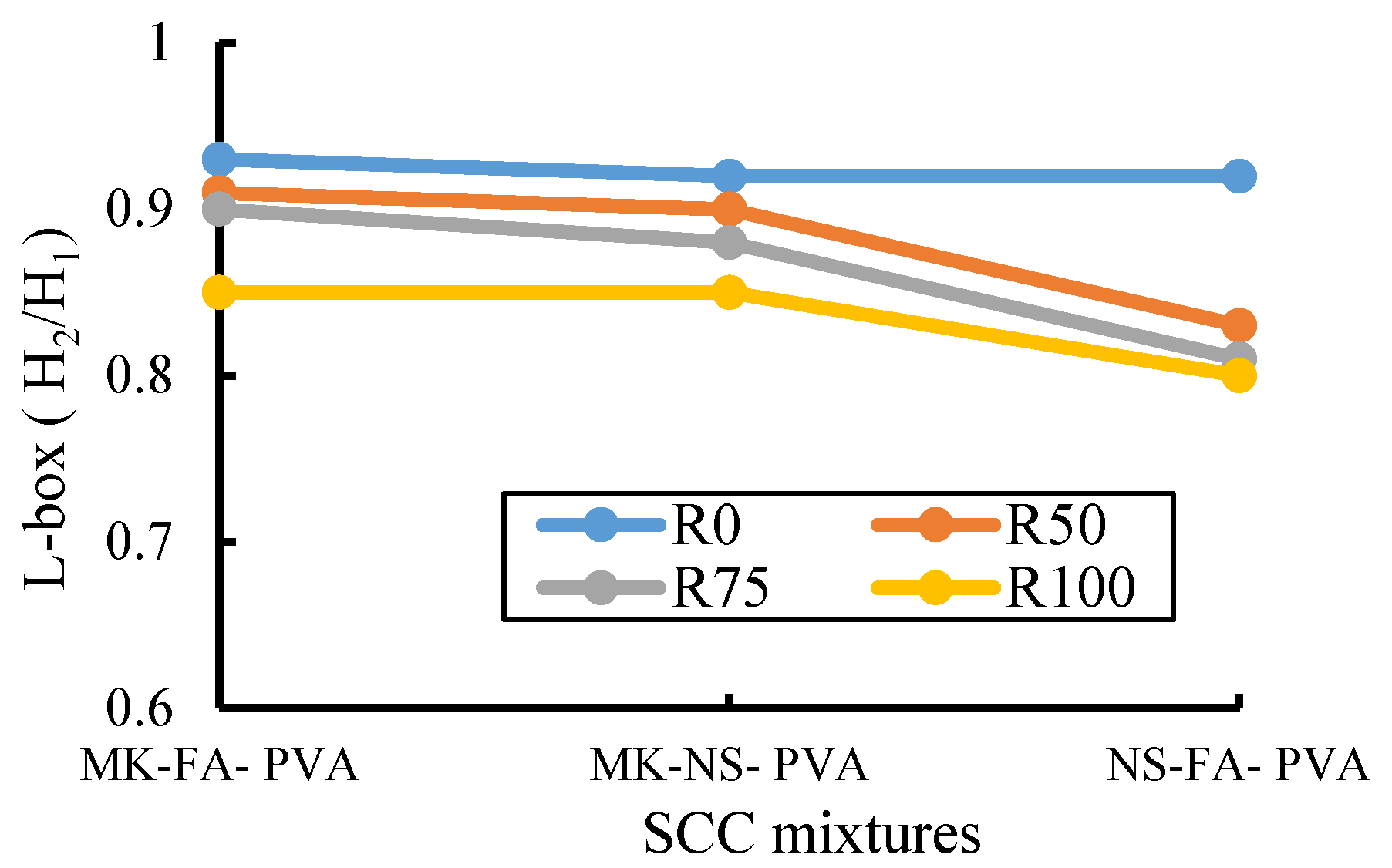
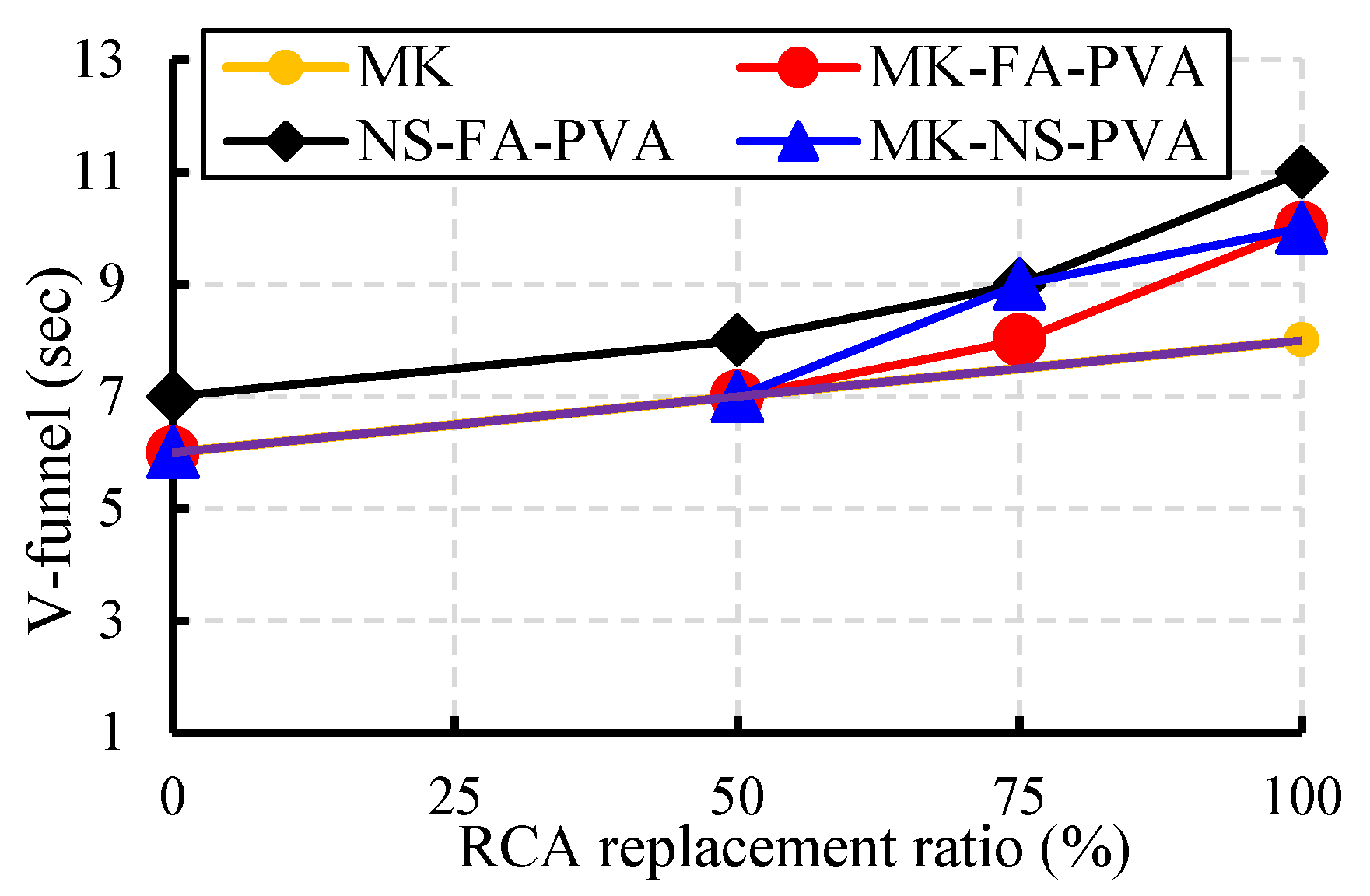


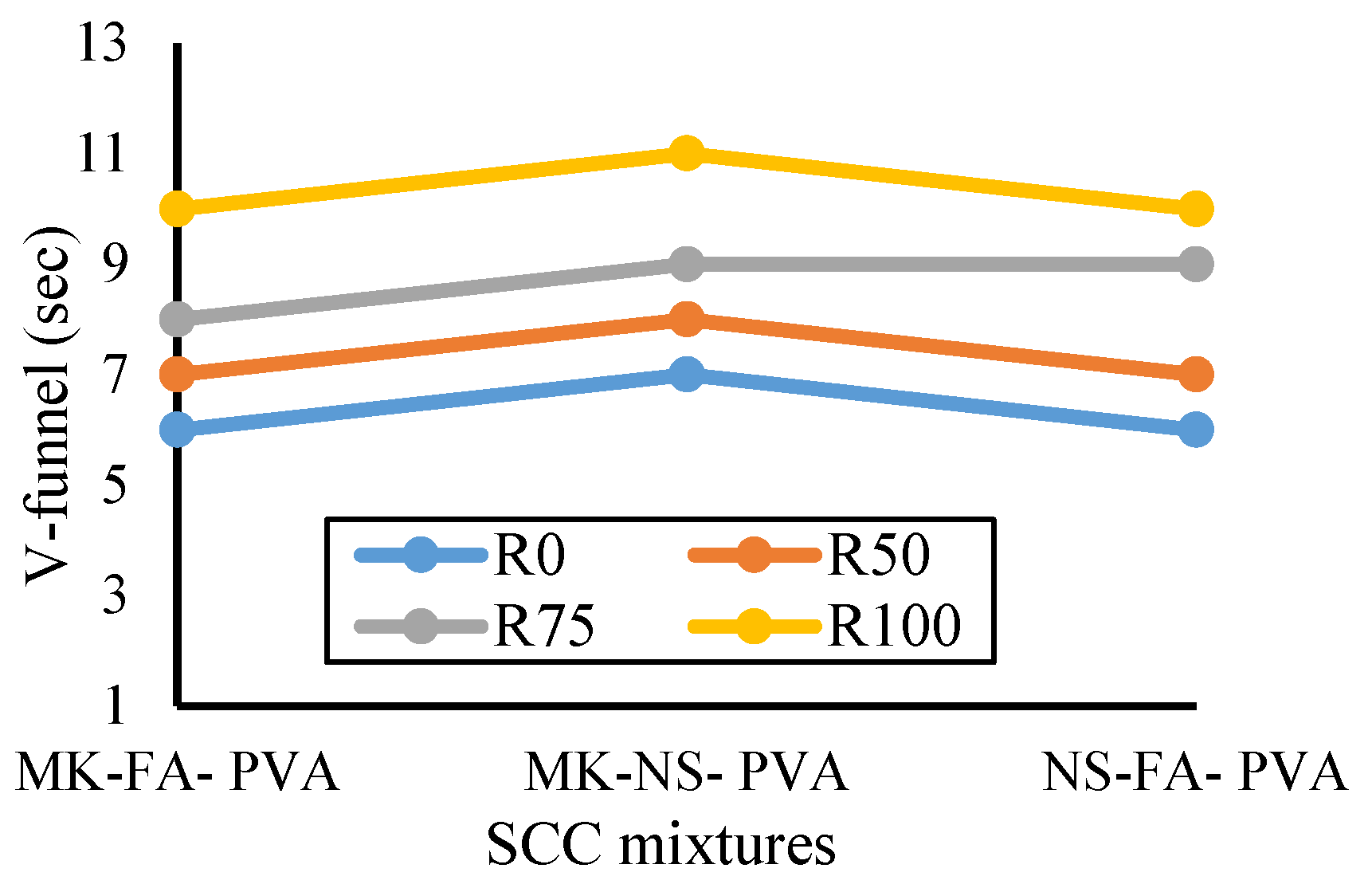

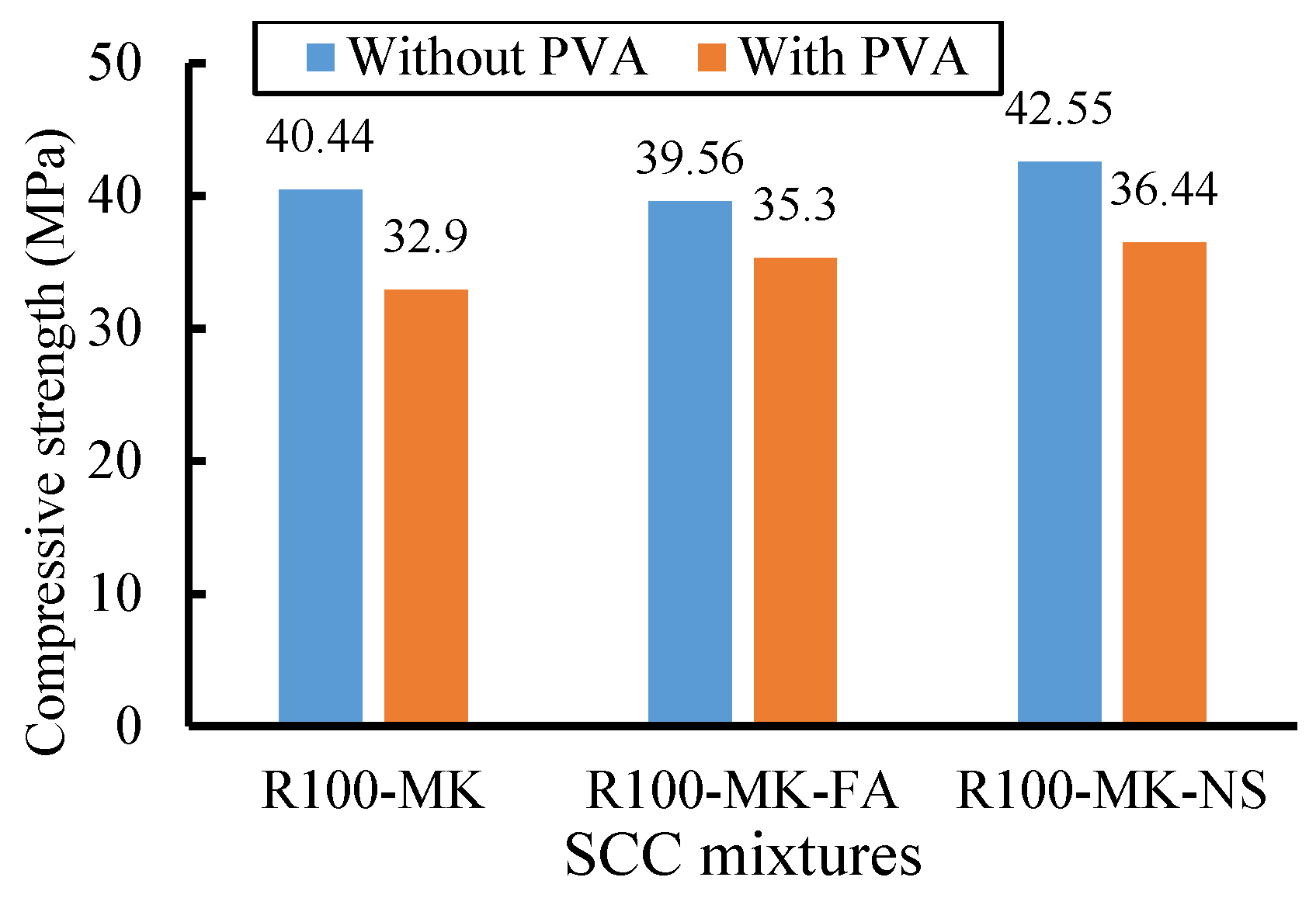


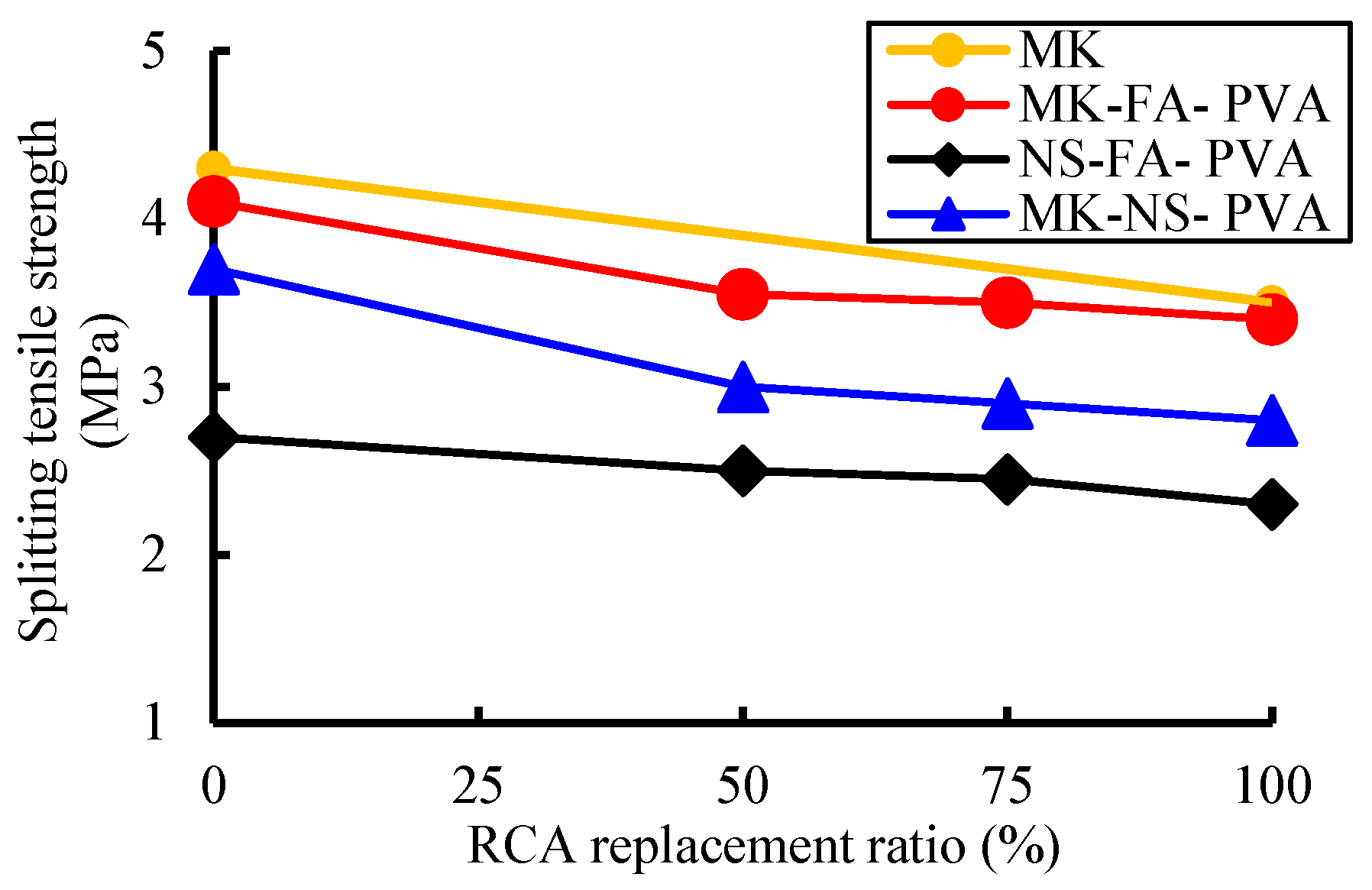
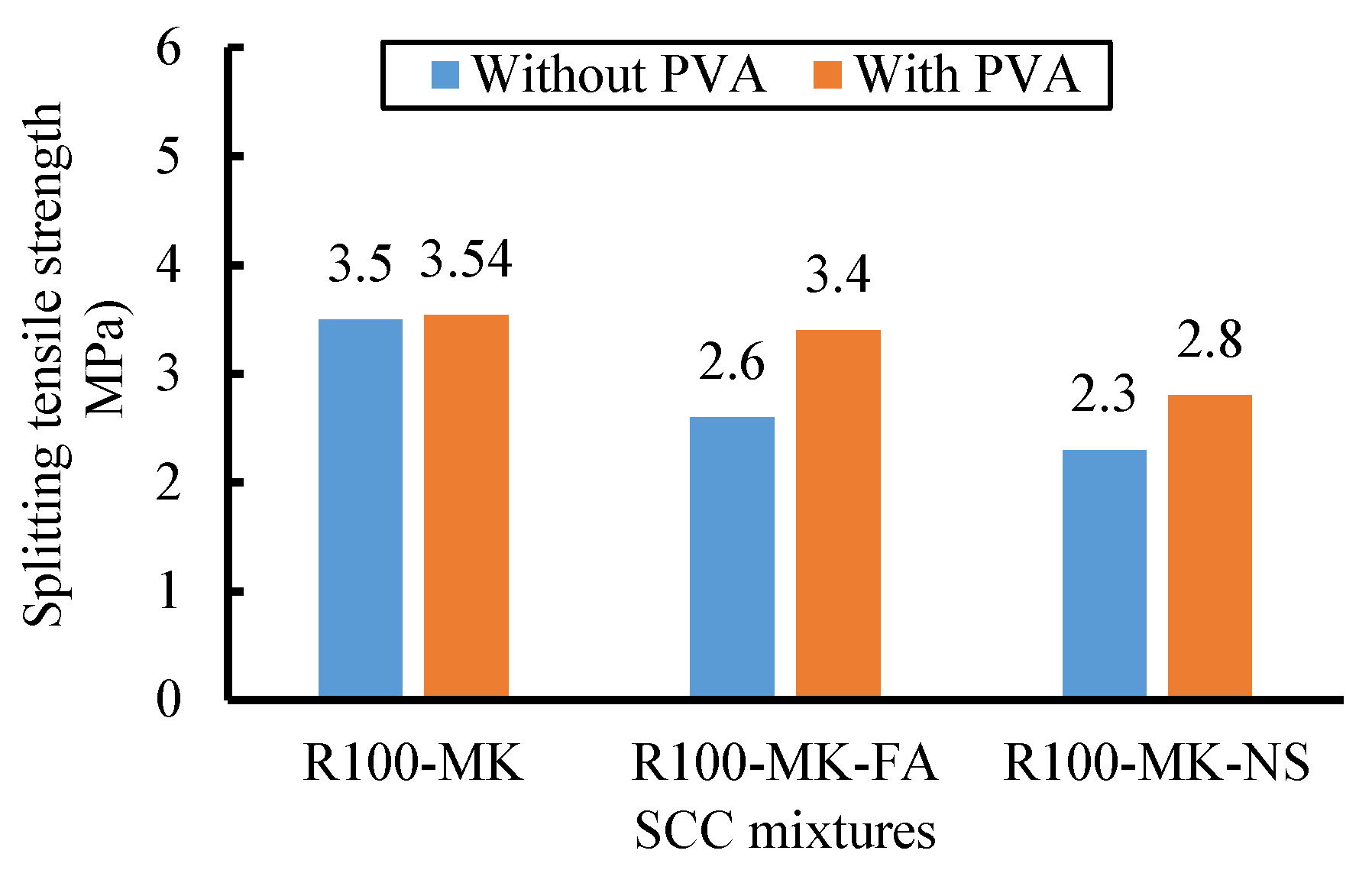
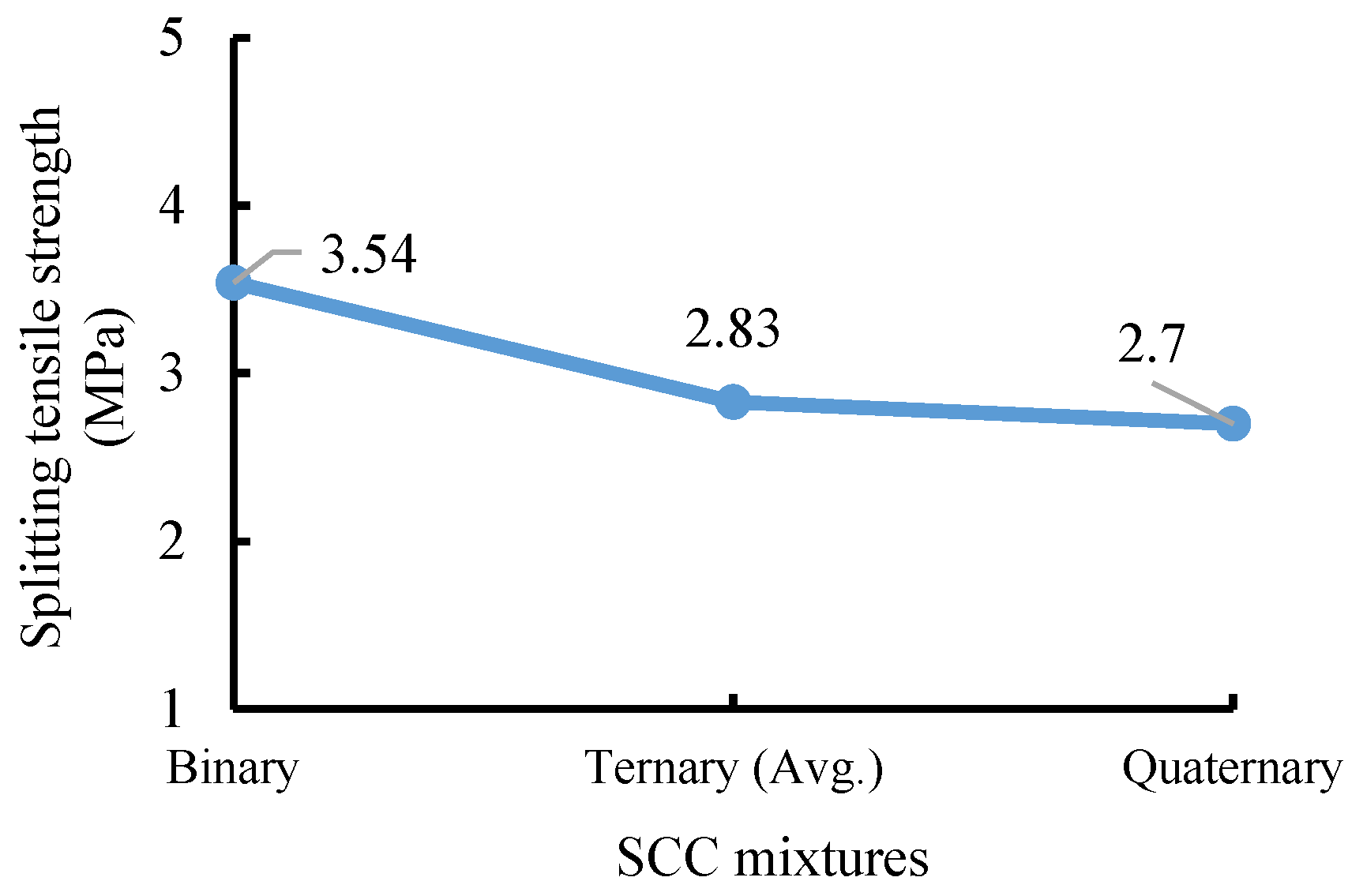
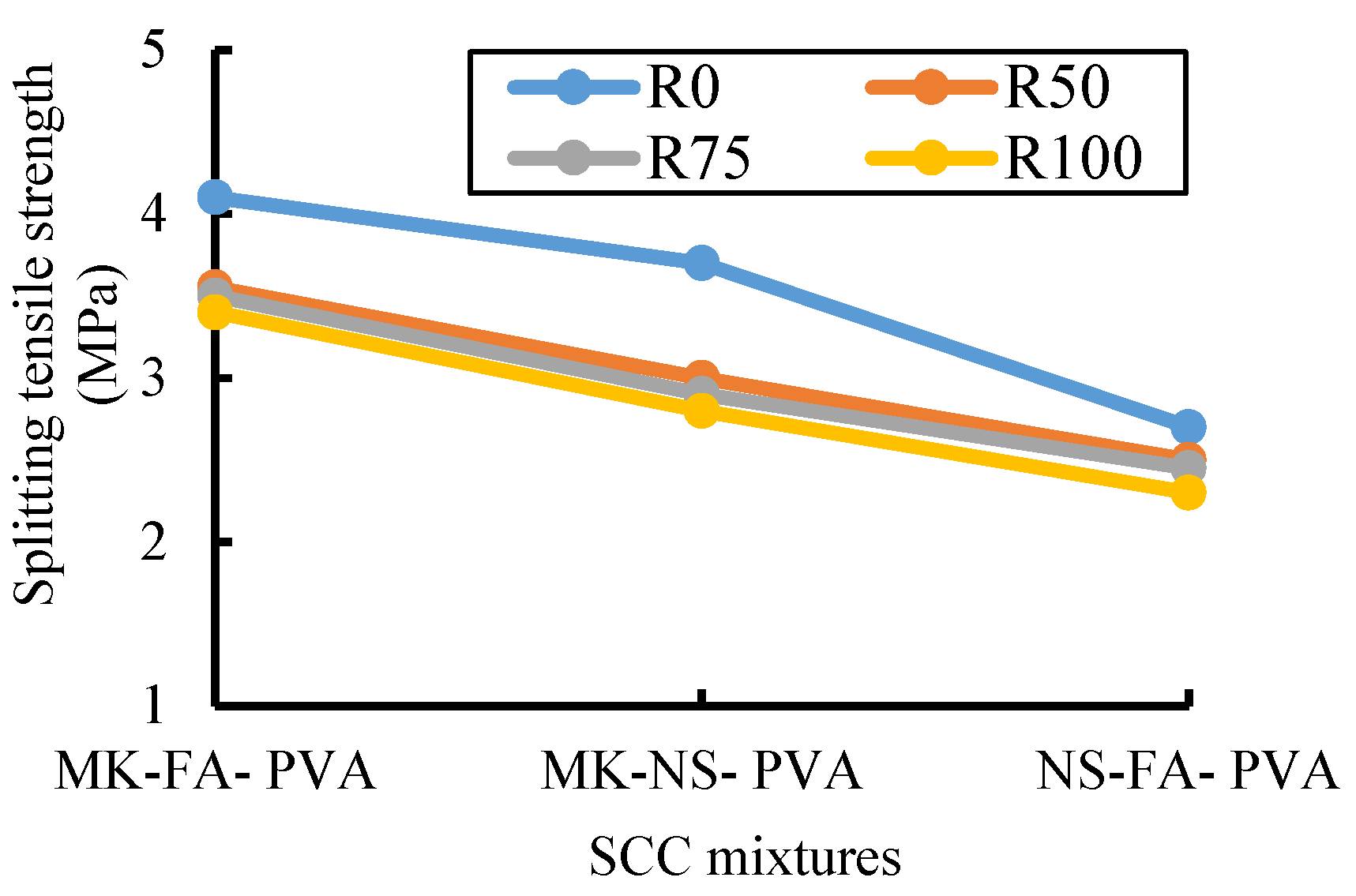
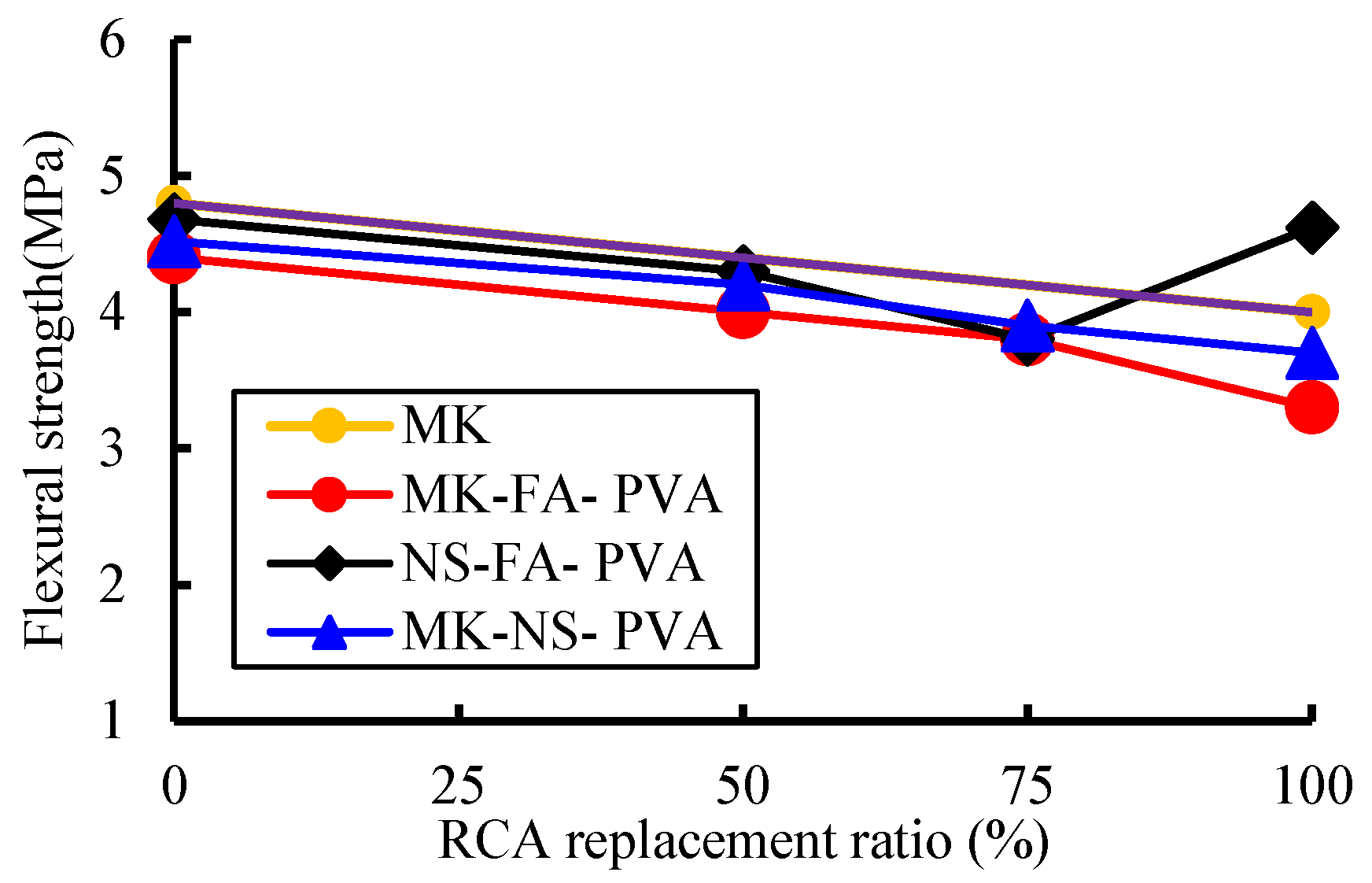



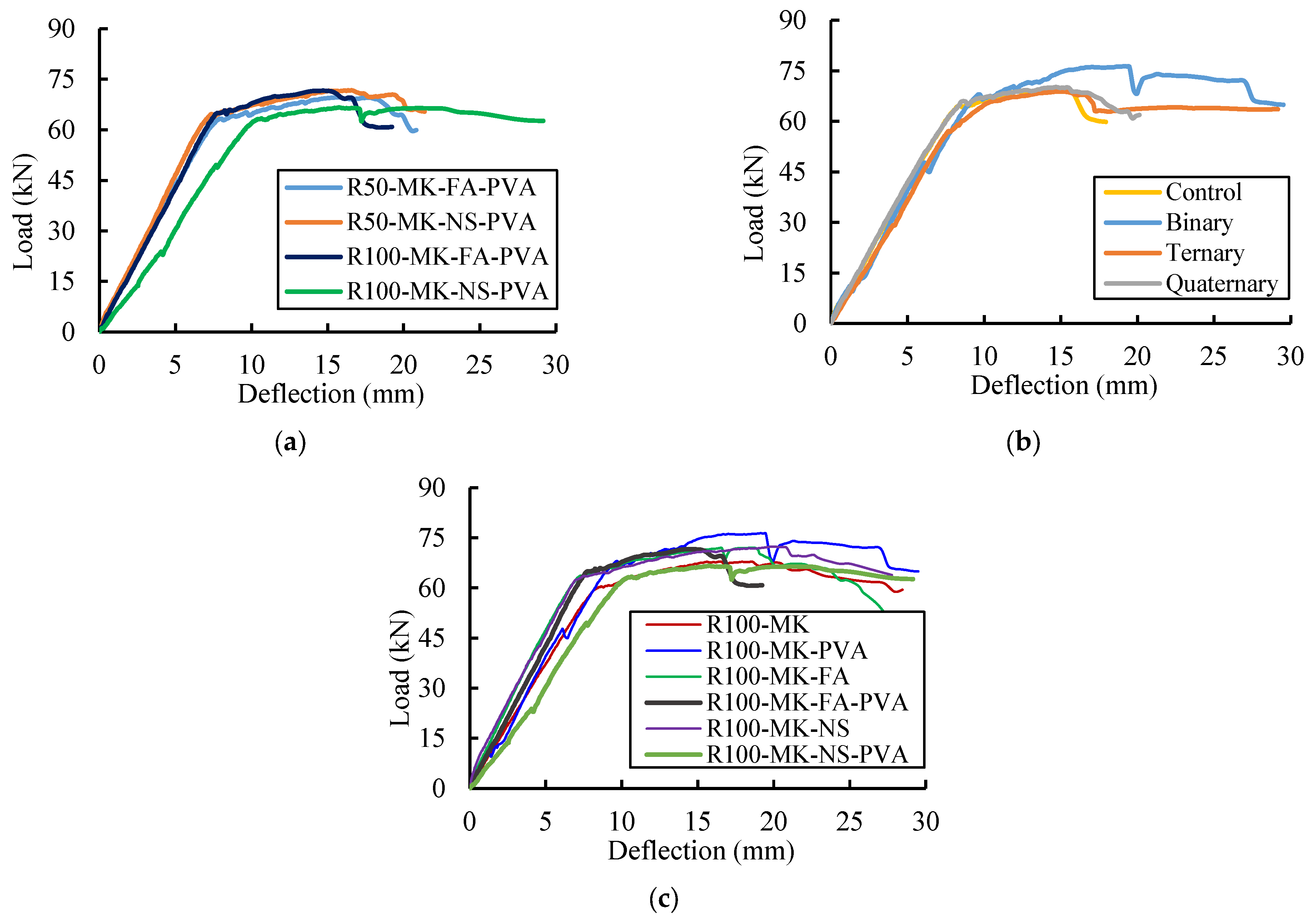
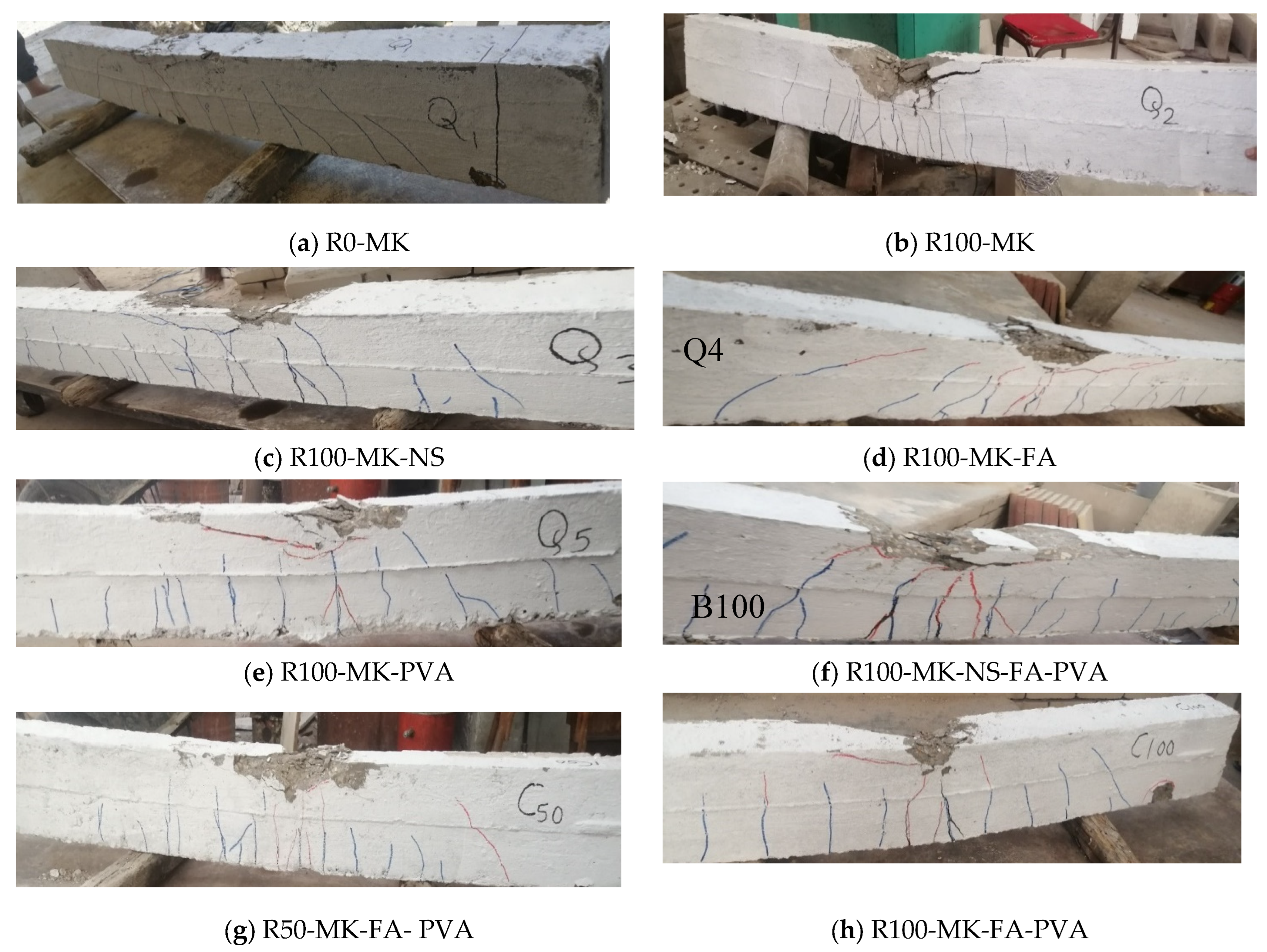

| Compound | Cement | Fly Ash | Metakaolin | Nano-Silica |
|---|---|---|---|---|
| SiO2 | 21.20 | 55.20 | 52.25 | 90 |
| Fe2O3 | 3.80 | 8.4 | 1.50 | 0.18 |
| Al2O3 | 4.50 | 21.9 | 41.25 | 0.44 |
| CaO | 62.3 | 5.23 | 1.20 | 0.30 |
| K2O | 0.65 | 1.20 | .65 | 0.05 |
| MgO | 2.4 | 1.53 | 0.15 | 0.07 |
| Na2O | 0.36 | 1.60 | 0.28 | 0.08 |
| LIO | 1.93 | 1.95 | 1.02 | 3.29 |
| Loss on ignition | 0.13 | 2.39 | 2.70 | 0.29 |
| Specific gravity (g/m3) | 3.15 | 2.20 | 2.60 | 1.40 |
| Item in Mix | Specific Gravity | Fineness Modulus | Maximum Nominal Size (mm) |
|---|---|---|---|
| NCA | 2.68 | 6.48 | 14 |
| RCA | 2.62 | 6.98 | 20 |
| Sand | 2.65 | 2.6 | - |
| Mix ID | Mix Description | Water | Binder | NCA | RCA | Sand | PVA Fibers | |||
|---|---|---|---|---|---|---|---|---|---|---|
| Cement | MK | NS | FA | |||||||
| Q1 | R0-MK | 223 | 450 | 90 | 0 | 0 | 814.0 | 0 | 721.7 | 0 |
| C0 | R0-MK-FA-PVA | 223 | 450 | 90 | 0 | 99 | 746.8 | 0 | 662.3 | 3.6 |
| D0 | R0-MK-NS-PVA | 223 | 450 | 90 | 13.5 | 0 | 796.6 | 0 | 706.4 | 3.6 |
| A0 | R0-NS-FA-PVA | 223 | 450 | 0 | 13.5 | 99 | 782.0 | 0 | 693.0 | 3.6 |
| C50 | R50-MK-FA-PVA | 223 | 450 | 90 | 0 | 99 | 373.4 | 377.7 | 662.3 | 3.6 |
| D50 | R50-MK-NS-PVA | 223 | 450 | 90 | 13.5 | 0 | 398.3 | 402.9 | 706.4 | 3.6 |
| A50 | R50-NS-FA-PVA | 223 | 450 | 0 | 13.5 | 99 | 391.0 | 395.5 | 693.0 | 3.6 |
| C75 | R75-MK-FA-PVA | 223 | 450 | 90 | 0 | 99 | 186.7 | 566.5 | 662.3 | 3.6 |
| D75 | R75-MK-NS-PVA | 223 | 450 | 90 | 13.5 | 0 | 199.2 | 604.3 | 706.4 | 3.6 |
| A75 | R75-NS-FA-PVA | 223 | 450 | 0 | 13.5 | 99 | 195.5 | 593.2 | 693.0 | 3.6 |
| Q2 | R100-MK | 223 | 450 | 90 | 0 | 0 | 0 | 823.3 | 721.7 | 0 |
| Q4 | R100-MK-FA | 223 | 450 | 90 | 0 | 99 | 0 | 759.3 | 665.8 | 0 |
| Q3 | R100-MK-NS | 223 | 450 | 90 | 13.5 | 0 | 0 | 809.7 | 709.8 | 0 |
| Q5 | R100-MK-PVA | 223 | 450 | 90 | 0 | 0 | 0 | 819.3 | 718.4 | 3.6 |
| C100 | R100-MK-FA-PVA | 223 | 450 | 90 | 0 | 99 | 0 | 755.4 | 662.3 | 3.6 |
| D100 | R100-MK-NS-PVA | 223 | 450 | 90 | 13.5 | 0 | 0 | 805.7 | 706.4 | 3.6 |
| A100 | R100-NS-FA-PVA | 223 | 450 | 0 | 13.5 | 99 | 0 | 791.0 | 693.0 | 3.6 |
| B100 | R100-MK-NS-FA-PVA | 223 | 450 | 90 | 13.5 | 99 | 0 | 741.8 | 650.3 | 3.6 |
| Steel Type | Yield Strength (MPa) | Ultimate Tensile Strength (MPa) | Elastic Modulus (MPa) | % Elongation |
|---|---|---|---|---|
| 400/600 | 400 | 600 | 210,000 | 15 |
| 280/450 | 280 | 450 | 210,000 | 30 |
| Mix Description | Slump Flow (mm) | SI | L-Box (H2/H1) | V-Funnel (s) |
|---|---|---|---|---|
| R0-MK | 790 | 0 | 0.95 | 6.0 |
| R0-MK-FA-PVA | 740 | 0 | 0.93 | 6.0 |
| R0-MK-NS-PVA | 700 | 0 | 0.92 | 7 |
| R0-NS-FA-PVA | 730 | 0 | 0.92 | 6 |
| R50-MK-FA-PVA | 705 | 0 | 0.91 | 7 |
| R50-MK-NS-PVA | 650 | 0 | 0.90 | 8 |
| R50-NS-FA-PVA | 665 | 0 | 0.83 | 7 |
| R75-MK-FA-PVA | 680 | 1 | 0.90 | 8 |
| R75-MK-NS-PVA | 620 | 1 | 0.88 | 9 |
| R75-NS-FA-PVA | 630 | 0 | 0.81 | 9 |
| R100-MK | 690 | 1 | 0.92 | 8.0 |
| R100-MK-FA | 660 | 1 | 0.92 | 9.0 |
| R100-MK-NS | 640 | 0 | 0.92 | 9.5 |
| R100-MK-PVA | 620 | 1 | 0.85 | 10 |
| R100-MK-FA-PVA | 590 | 1 | 0.85 | 10 |
| R100-MK-NS-PVA | 585 | 2 | 0.85 | 11 |
| R100-NS-FA-PVA | 570 | 1 | 0.80 | 10 |
| R100-MK-NS-FA-PVA | 560 | 2 | 0.80 | 11 |
| Mix Description | Compressive Strength (MPa) | Splitting Strength (MPa) | Flexural Strength (MPa) | ||
|---|---|---|---|---|---|
| 7 Days | 28 Days | 56 Days | |||
| R0-MK (Control) | 37.33 | 43.11 | 56.50 | 4.30 | 4.80 |
| R0-MK-FA-PVA | 35.55 | 42.22 | 53.80 | 4.10 | 4.40 |
| R0-MK-NS-PVA | 32.80 | 42.60 | 48.60 | 3.70 | 4.52 |
| R0-NS-FA-PVA | 26.10 | 32.50 | 53.80 | 2.70 | 4.68 |
| R50-MK-FA-PVA | 31.67 | 40.00 | 50.20 | 3.55 | 4.00 |
| R50-MK-NS-PVA | 31.64 | 40.41 | 44.10 | 3.00 | 4.20 |
| R50-NS-FA-PVA | 22.50 | 30.00 | 42.10 | 2.50 | 4.30 |
| R75-MK-FA-PVA | 30.10 | 39.85 | 48.50 | 3.50 | 3.80 |
| R75-MK-NS-PVA | 30.62 | 38.89 | 39.80 | 2.90 | 3.90 |
| R75-NS-FA-PVA | 22.10 | 29.30 | 38.80 | 2.45 | 3.80 |
| R100-MK | 31.11 | 40.44 | 49.60 | 3.50 | 4.00 |
| R100-MK-FA | 37.33 | 39.56 | 47.60 | 2.60 | 3.70 |
| R100-MK-NS | 36.90 | 42.55 | 54.80 | 2.30 | 3.93 |
| R100-MK-PVA | 26.70 | 32.90 | 40.20 | 3.54 | 3.80 |
| R100-MK-FA-PVA | 28.70 | 35.30 | 45.60 | 3.40 | 3.30 |
| R100-MK-NS-PVA | 27.33 | 36.44 | 35.00 | 2.80 | 3.70 |
| R100-NS-FA-PVA | 21.35 | 28.44 | 35.70 | 2.30 | 4.62 |
| R100-MK-NS-FA-PVA | 29.33 | 39.11 | 45.50 | 2.70 | 3.30 |
| Beam Description | Cracking Load (kN) | Cracking Moment (kN·m) | Ultimate Load (kN) | Moment Capacity (kN·m) | Flexural Stiffness (kN/mm) | Maximum Deflection (mm) |
|---|---|---|---|---|---|---|
| R0-MK (Control beam) | 55.00 | 13.75 | 69.80 | 17.45 | 8.00 | 14.80 |
| R50-MK-FA-PVA | 50.00 | 12.50 | 69.60 | 17.40 | 8.80 | 15.60 |
| R50-MK-NS-PVA | 50.00 | 12.50 | 71.70 | 17.93 | 8.90 | 16.60 |
| R100-MK | 45.00 | 11.25 | 67.90 | 16.98 | 7.40 | 16.40 |
| R100-MK-FA | 50.00 | 12.50 | 72.00 | 18.00 | 9.30 | 18.55 |
| R100-MK-NS | 48.00 | 12.00 | 72.40 | 18.10 | 8.80 | 20.00 |
| R100-MK-PVA | 53.00 | 13.25 | 76.40 | 19.10 | 7.50 | 19.14 |
| R100-MK-FA-PVA | 45.00 | 11.25 | 71.60 | 17.90 | 8.31 | 15.80 |
| R100-MK-NS-PVA | 45.00 | 11.25 | 66.60 | 16.65 | 6.40 | 16.75 |
| R100-MK-NS-FA-PVA | 51.00 | 13.00 | 70.20 | 17.55 | 8.15 | 14.70 |
Disclaimer/Publisher’s Note: The statements, opinions and data contained in all publications are solely those of the individual author(s) and contributor(s) and not of MDPI and/or the editor(s). MDPI and/or the editor(s) disclaim responsibility for any injury to people or property resulting from any ideas, methods, instructions or products referred to in the content. |
© 2023 by the authors. Licensee MDPI, Basel, Switzerland. This article is an open access article distributed under the terms and conditions of the Creative Commons Attribution (CC BY) license (https://creativecommons.org/licenses/by/4.0/).
Share and Cite
Ahmed, S.; El-Zohairy, A.; Eisa, A.S.; Mohamed, M.A.E.-A.B.; Abdo, A. Experimental Investigation of Self-Compacting Concrete with Recycled Concrete Aggregate. Buildings 2023, 13, 856. https://doi.org/10.3390/buildings13040856
Ahmed S, El-Zohairy A, Eisa AS, Mohamed MAE-AB, Abdo A. Experimental Investigation of Self-Compacting Concrete with Recycled Concrete Aggregate. Buildings. 2023; 13(4):856. https://doi.org/10.3390/buildings13040856
Chicago/Turabian StyleAhmed, Sayed, Ayman El-Zohairy, Ahmed S. Eisa, Mohamed Abd El-Aziz Badran Mohamed, and Ayman Abdo. 2023. "Experimental Investigation of Self-Compacting Concrete with Recycled Concrete Aggregate" Buildings 13, no. 4: 856. https://doi.org/10.3390/buildings13040856






